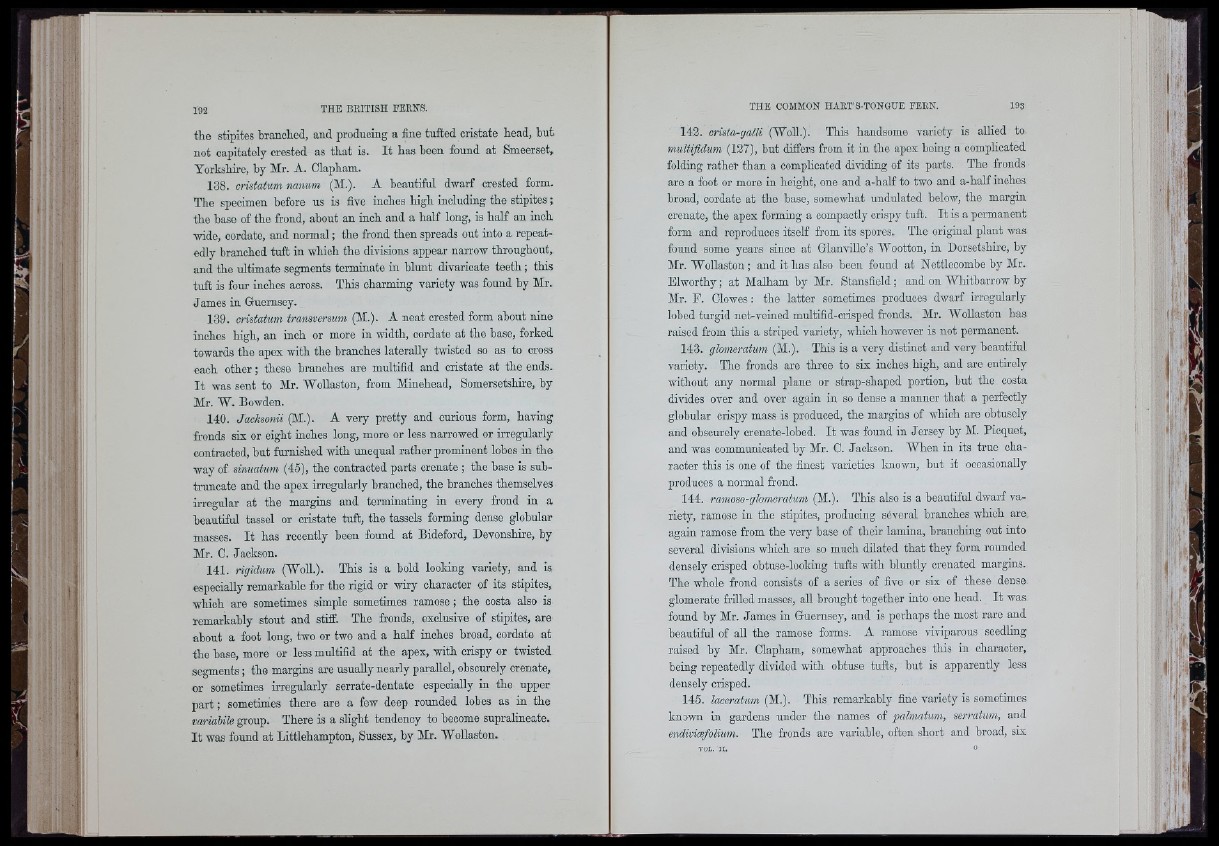
iiii
:fi}|
,,'li
I
ii' i
the stipites branched, and producing a fine tufted cristate head, hut
not oapitatoly crested as that is. It has been found at Smeerset,
Yorkshire, by Air. A. Clapham.
138. cristatum nanum (AI.). A beautiful dwarf crested form.
The specimen before us is five inches high including the stipites ;
the base of the frond, about an inch and a half long, is half an inch
wide, cordate, and normal; the frond then spreads out into a repeatedly
branched tuft in which the divisions appear narrow throughout,
and the ultimate segments terminate in blunt divaricate teeth; this
tuft is four inches across. This charming variety was found by Air.
James in Guernsey.
139. cristatum transversum (AI.). A neat crested form about nine
inches high, an inch or more in width, cordate at the base, forked
towards the apex with the branches laterally twisted so as to cross
each other; these branches are multifid and cristate at the ends.
It was sent to Air. AVoUaston, from Alinehead, Somersetshire, by
Air. AY. Bowden.
140. Jacksonii (AI.). A very pretty and curious form, having
fronds six or eight inches long, more or less narrowed or irregularly
contracted, hut furnished with unequal rather prominent lobes in the
way of sinuatum (45), the contracted parts crenate ; the base is sub-
truncate and the apex irregularly branched, the branches themselves
irregular at the margins and terminating in every frond in a
beautiful tassel or cristate tuft, the tassels forming dense globular
masses. It has recently been found at Bideford, Devonshire, by
Air. C. Jackson.
141. rigidum (AVoll.). This is a bold looking variety, and is
especially remarkable for the rigid or wiry character of its stipites,
which are sometimes simple sometimes ramose ; the costa also is
remarkably stout and stiff. The fronds, exclusive of stipites, are
about a foot long, two or two and a half inches broad, cordate at
the base, more or less multifid at the apex, with crispy or twisted
segments; the margins are usuaUy nearly paraUel, obscurely crenate,
or sometimes irregularly serrate-dentate especially in the upper
part; sometimes there are a few deep rounded lohes as in the
variabile group. There is a sUght tendency to become supralineate.
It was found at Littlehampton, Sussex, by Air. AVollaston.
I ff
142. crista-galli (AVoU.). This handsome variety is allied to
multifldum (127), but differs from it in the apex hoing a compUcated
folding rather than a compUcated dividing of its parts. The fronds
are a foot or more in height, one and a-half to two and a-half inches
broad, cordate at the base, somewhat undulated below, the margin
crenate, the apex forming a compactly crispy tuft. It is a permanent
form and reproduces itself from its spores. The original plant was
found some years since at GlanviUe’s AVootton, in Dorsetshire, by
Air. AVollaston; and it has also been found at Nettlecombe by Air.
Elworthy; at Alalham by Air. Stansfield; and on AVhitbarrow by
Air. F. Olowes : the latter sometimes produces dwarf irregularly
lobed turgid net-veined multifid-orisped fronds. Air. AVollaston has
raised from this a striped variety, which however is not permanent.
143. ghmeratum (AI.). This is a very distinct and very beautiful
variety. The fronds are three to six inches high, and are entirely
without any normal plane or strap-shaped portion, bnt the oosta
divides over and over again in so dense a manner that a perfectly
globular crispy mass is produced, the margins of which are obtusely
and obscurely crenate-lobed. It was found in Jersey by AI. Pioquet,
and was communioated by Air. C. Jackson. AAUion in its true character
this is one of the finest varieties known, but it occasionally
produces a normal frond.
144. ramoso-glomeratum (AI.). This also is a beautiful dwarf variety,
ramose in the stipites, producing several branches which are
again ramose from the very base of their lamina, branching out into
several divisions which are so much dilated that they form rounded
densely crisped obtuse-looking tufts with bluntly oronatod margins.
The whole frond consists of a series of five or six of these dense
glomerate frilled masses, all brought together into one head. It was
found by Air. James in Guernsey, and is perhaps the most rare and
beautiful of all the ramose forms. A ramose viviparous seedling
raised by Air. Clapham, somewhat approaches this in character,
being repeatedly divided with obtuse tufts, but is apparently less
densely crisped.
145. laceratum (AI.). This remarkably fine variety is sometimes
known in gardens under the names of palmatum, serratum, and
The fronds are variable, often short and broad, six
ri
\\\
■t :
iDik'
ri!
■ '(!tri|
k
■!’ 11
jw-y